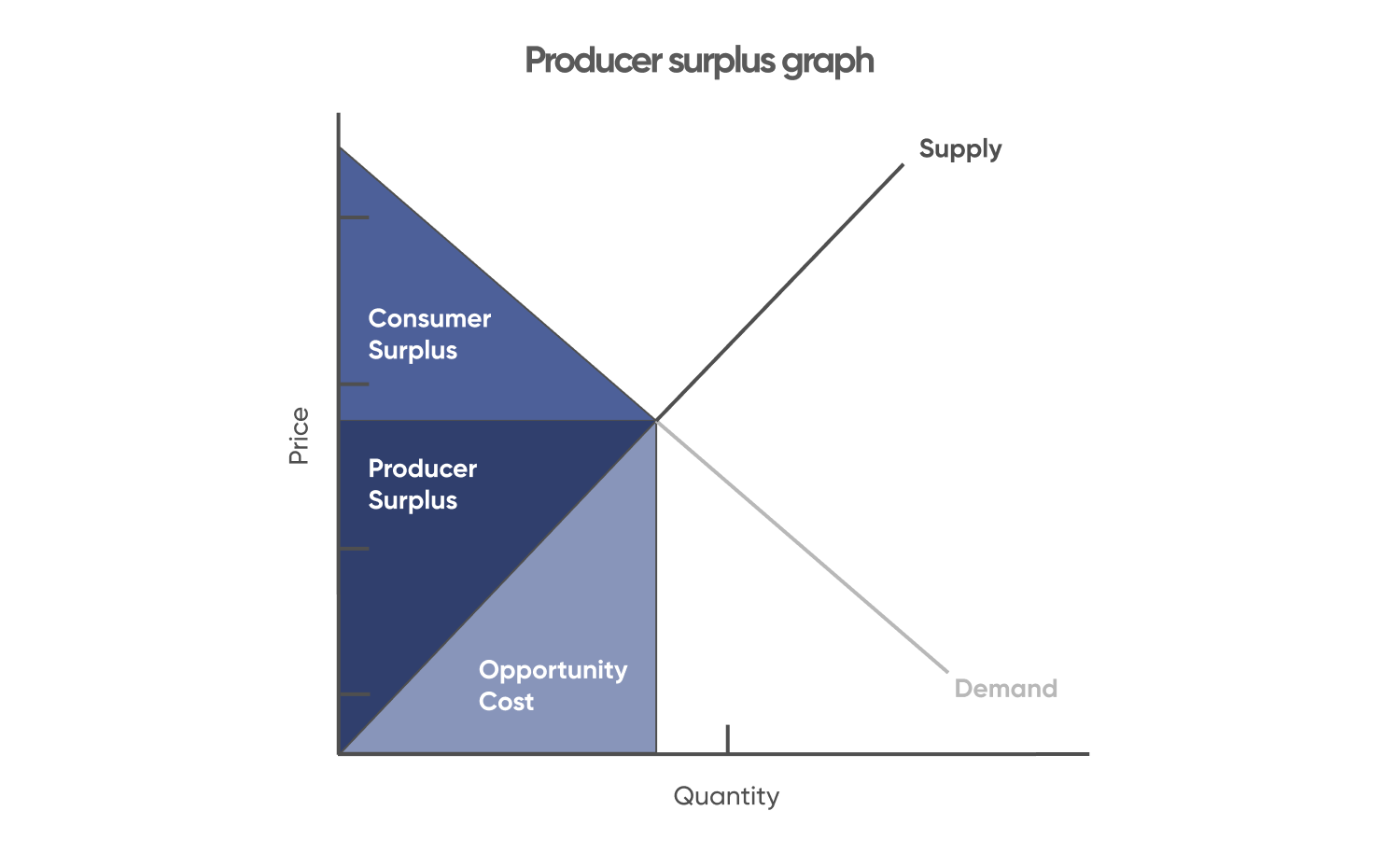What is a producer surplus?

What is a producer surplus?
A producer surplus is the difference between what a producer of a good is willing to sell their product for and what they actually do sell it for.
To put it another way, the producer surplus is the amount of money a producer theoretically makes from producing and then selling goods at the market price. It is important as it can serve as an incentive for someone to risk their time and money in business.
Highlights
- The producer surplus is the difference between what a producer might sell their product for and its actual market price.
- Changes in price, supply and demand can have an impact on producer surplus.
- The difference between producer surplus and profit is that profit takes both fixed and marginal costs into account, while producer surplus only takes marginal costs into account.
How producer surplus is calculated
Producer surplus can be obtained by subtracting the total cost of production from the total revenue received from the sale of the goods. Therefore, the producer surplus formula that allows people to work out how to calculate producer surplus, in simple terms, would be as follows: Take the market price (p1) and subtract the minimum price the producer is willing to sell for (p2). Then multiply that number by the quantity (q) of goods and divide it by two. Or: 1/2xqx(p1-p2).

Factors that affect producer surplus
There are numerous factors that could affect producer surplus, these include:
-
Price changes. If either the price of making a good or its market value change, then the potential market surplus will change too.
-
Changes in demand. If there is a change in how much people want a good, the producer surplus changes. If demand falls the producer surplus will fall as there will either be less sales of the product or producers will lower prices to attract more buyers. Likewise, if it rises producers will be able to sell more or even raise prices to account for the increase in interest.
-
Changes in supply. If there are more products coming onto the market, the producer surplus could fall if consumers are either unable or unwilling to buy the same percentage of the product. On the other hand, a rise in supply could help the producer surplus providing the same percentage of products are sold.
Producer surplus example
Suppose a bakery produces a cupcake for $1 and is willing to sell it for $1 in order to recoup its money. However, the market price for a cupcake is currently $4. In this case, the producer surplus per cupcake would be $3 ($4 - $1), which represents the additional money earned by the bakery beyond the production cost. You can scale this up, so if 500 cupcakes are sold, then the total selling price is $2,000. However, the minimum price of all the cupcakes would be $500.
If we then halve the difference between $2,000 and $500, we get $750, which represents the producer surplus. The reason we have halved it is because half of the $1,500 represents the consumer surplus.

Consumer surplus and producer surplus
Talking of consumer surplus, there is a difference between that and producer surplus. A consumer surplus is the difference between what a buyer is willing to pay for a product and the market price.
What’s the difference between producer surplus and profit?
It might look like producer surplus is just another, slightly more jargony, way of talking about profit, but there is a difference between the two. A profit is the total of overall costs plus overall revenue.
To put it another way, profits involve subtracting all costs, including fixed costs such as, in the case of our hypothetical bakeries, premises rent and machinery, from the revenue as well as the variable, or marginal, costs of making a number of goods. Producer surplus, meanwhile, only deducts the marginal costs from the revenue.
This means that, at least in theory, a business’s producer surplus will be higher than its profit, assuming it makes one. Indeed, theoretically, a company could make a producer surplus but not make a profit.
FAQs
How do you measure producer surplus?
Producer surplus is measured by subtracting the price a producer is willing to get for a product from its market price.
What is the simple definition of producer surplus?
The simple definition of a producer surplus is the difference between what a producer is willing to get for a product and its market price.
What is consumer surplus?
A consumer surplus is the difference between what a buyer is willing to pay for a product and the market price.
What is total surplus?
Total surplus is the sum total of producer and consumer surplus.